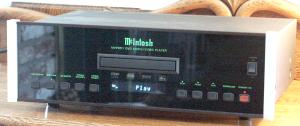McIntosh MVP851 DVD-V/DVD-A Player February, 2003 John E. Johnson, Jr.
|
Click Photo to See a Larger Version |
|
Specifications:
�
12 Bit Video DACs � XLR Audio Out for Front Channels � Heavy Steel Chassis � Size: 5 1/3" H x 17 1/2" W x 15" D � Weight: 20 Pounds � MSRP: $3,500 USA
McIntosh Laboratories
|
Introduction
McIntosh is a name brand that sticks in my mind, all the way back to when I
was a teenager dreaming of having "really good stuff". In those days, I
didn't even think about the expense. What I liked was the way they looked.
The glossy facade. Smooth edges. Like a snazzy automobile. But I wasn't
interested in cars. I liked hi-fi equipment. I couldn't afford things like
this, however, so I built my own.
Times are different now. I can afford McIntosh. Not that I am rich, because I am not. I still love hi-fi more than cars. In fact, I just bought an electric automobile, a Chrysler Gem. $6,000 out the door, including tax and license. It will go 25 mph for about 35 miles before an overnight recharge at 110 volts from a household socket. Perfect for just going to the Safeway, the Post Office, Radio Shack, Burger King, etc., here in Redwood City. I decided to just say no to the high price of oil and gasoline. To heck with a luxury automobile and $2.10 a gallon.
The point is that we spend our money on what we like the most. Good hi-fi components are expensive. You can get a DVD player at CostCo for $139. The McIntosh MVP851 is $3,500. Is it worth all that extra money?
The Design
The MVP851 is McIntosh's latest iteration of DVD players. It is not their first player, but it is their first DVD-A. The front panel is made of glass, and costs more than a lot of DVD players just by itself. The buttons are large and solid. Each one is backlit with the name of its function, which makes them very easy to locate in the dark. You can dim the panel, but not turn it off. Some consumers will consider this a disadvantage. I do not. I like the visibility of the components on my equipment rack, and McIntosh is famous for this. In particular, the VU meters on their power amplifiers with the blue back light are stunning. I would never turn those off.
The first button on the left side of the front panel (click photo above to see large version) is Progressive. This lets you switch from Interlaced output to Progressive Scan Output for the video signal. Since one is likely to set this once and leave it alone, I don't think it was necessary to put it on the front, but it is not really an issue. Next, are MPEG DNR and Re-Master. These are very relevant to the front panel, since, with some movies, noise reduction might be desired, depending on how the DVD was engineered. Re-Master is Mc's term for Upsampling, which makes it easier for the digital filters to do their job. When you activate this button, 44.1 kHz is upsampled to a higher sampling frequency, and the digital filters can then remove noise without impeding the audible band of frequencies. When playing DVD-A, which is already at a high sampling frequency (96 kHz), obviously Re-Master is not pertinent. You might not want to always use upsampling either.
The 851 chassis is heavy. This may not seem important, but for those consumers who consider chassis vibration from subwoofers an issue, a heavy chassis is a welcome feature. The disc transport operates smoothly.
Knowing McIntosh, I suspected that the power supply for the 851 is rather special. At CES 2003, I interviewed Ted Saito, who is the chief engineer responsible for the 851 design. Here is what he had to say about the power supply.
The rear panel has coaxial and Toslink optical digital outputs, a set of 5.1 RCA analog outputs for DVD-A, composite RCA video out, an S-Video output, and a set of RCA component video outputs. You would find these on any DVD-A player. What you won't find on most other players is the set of balanced (XLR) audio outputs for the front left and right channels. These are true balanced outputs rather than just convenience outputs with pins 1 and 3 soldered together.
(Click photo to see a larger version.)
There are also IR jacks, remote turn-on jacks, and a grounded AC receptacle for use with a detachable AC power cord (included).
The remote control is rather simple, as shown below (click on the photo to see a larger version). It is backlit and easy to use. I think Mc understands that consumers don't necessarily appreciate having a zillion buttons on a remote control to deal with.
The Performance
I connected the MVP851 to my Theta Casablanca II, via Toslink optical for DD and DTS, stereo CD, and two-channel analog out for stereo DVD-A. I used component video out to my Sony 10HT LCD projector. For multi-channel DVD-A, I connected the 5.1 analog out on the 851 to a passive six-channel potentiometer that was custom built for an experiment that I published recently (the Theta does not have a set of 5.1 analog inputs). Other components included a Rotel RMB-1095 power amplifier, Threshold, Krix, and Monitor Audio speakers. Cables were Nordost and BetterCables.
In terms of video, the MVP851 has one of the best pictures I have ever seen. Colors are rich and saturated. No chroma bug. In fact, after the review, it was a pain to go back to my other DVD player. The only issue is that it uses an older Genesis deinterlacing chip that produces combing on bad discs. A full report on the video tests will be published in our Benchmark section later.
The audio quality was great on the 851. All music sounded crystal clear. Using a set of 5.1 analog outputs on a DVD player, connected to the 5.1 analog inputs on a processor or receiver is annoying, but until digital copyright issues are completely solved (it looks like DVI/HDCP/HDMI is going to do that in 2003-2004), we have to use them. However, there is one advantage of the 5.1 analog connections. Every disc that I played on the 851 produced audio without a hitch. DD movies, DTS CD music, DVD-A all played without my having to switch anything on the player or processor (in this case, the passive volume control). I didn't have to worry whether or not I was actually decoding DD or just sending two-channel audio that was converted to surround sound by Dolby Pro Logic.
DVD-A (and SACD) are wonderful additions to our music enjoyment possibilities. In my experiences so far, I am finding that classical music is showing up in SACD format, while pop titles are in DVD-A. So, I would have preferred that the 851 be a universal player, but McIntosh informed me that such a unit is in the works during the next 12 months.
On the Bench
Below are shown the distortion measurements for the 851. With a -10 dB 1 kHz track, THD+Noise was about 0.03% I would have liked to have seen it a little lower.
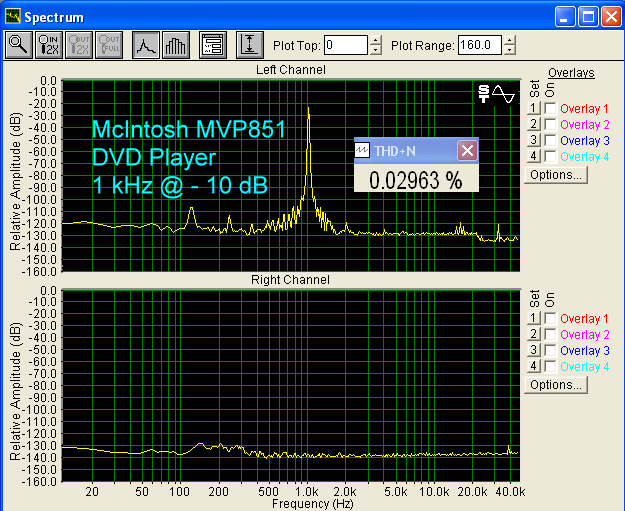
With an IMD signal, distortion came in at 0.02%. Again, I would have liked to have seen this a little lower.
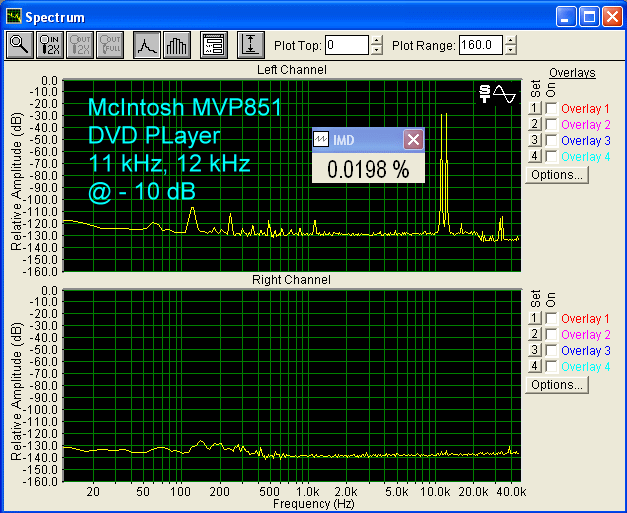
Frequency response results are shown below. With a test CD, response was within 0.2 dB from 20 Hz to 20 kHz. This is excellent.
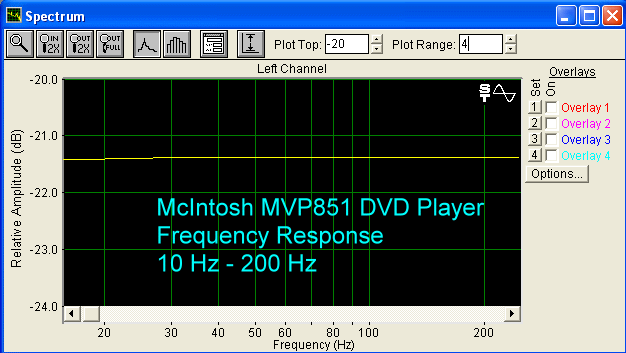

Using a DVD with test signals at 24/96, response was, again, within 0.2 dB to 20 kHz.
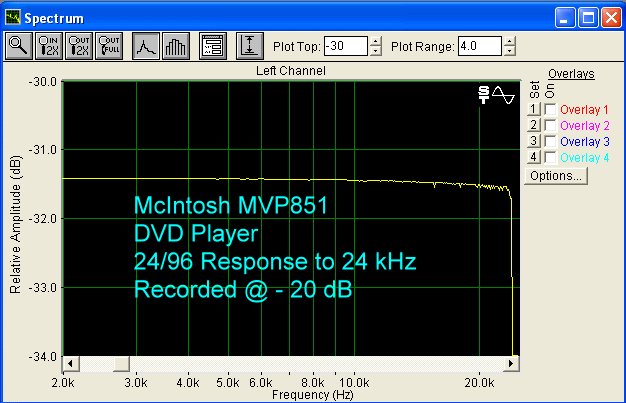
At 48 kHz, response is down only 0.4 dB. Again, this is excellent.

Conclusions
The McIntosh MVP851 is a fine player. I did not have any issues with the audio at all. For video, it does comb on bad discs, but that is the fault of poor disc engineering. I suspect this will be fixed on the universal player that they are planning, by using one of the new deinterlacers that covers up lousy disc quality.
- John E. Johnson, Jr. -
|
� Copyright 2003 Secrets of
Home Theater & High Fidelity |
![]()

